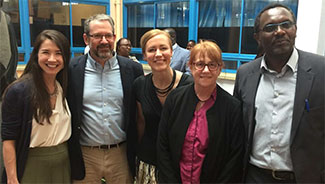Opinion: New energy for global health is blossoming across NIH
March / April 2019 | Volume 18, Number 2
Opinion by Fogarty Director Dr Roger I Glass
There’s a new wave of enthusiasm for global health sweeping across NIH. In addition to the
continuing strong support from NIH Director Dr. Francis S. Collins, I’m pleased to have three new institute directors on campus who share our passion to build research capacity and fund studies to improve the health of the world’s least fortunate.
I was delighted to be joined in Kenya recently by the relatively new directors of the institutes concerned with mental and child health research. There, they were able to see firsthand the impact their programs are having on the ground.

Image courtesy of NIMH/NIH

Image courtesy of NICHD/NIH
NIMH Director Dr. Josh Gordon (top, second from left) and
NICHD Director Dr. Diana Bianchi (bottom, center holding
baby) joined Fogarty Director Dr. Roger I. Glass in Kenya
recently to see firsthand the impact NIH-supported programs
are having on the ground.
A visit to an innovative project in rural, western Kenya particularly impressed National Institute of Mental Health (NIMH) Director Dr. Josh Gordon. By enhancing irrigation and improving productivity of farmers living with HIV, researchers found it’s more likely the farmers will adhere to their antiviral medication regimens and keep their clinic appointments. A few hours' drive away in Eldoret, Kenyan and U.S. researchers are studying how to keep adolescents with HIV on treatment using peer advisors and group therapy. They’re also investigating how to treat depression and trauma to improve control of HIV infection, and alleviate mental health symptoms. I encourage you to read
Dr. Gordon’s full blog post about his travels, which he sums up with this observation, “Through cutting-edge research around the world, global efforts yield truly global impacts.”
I’m also excited to see that NIMH is marking 10 years of its annual
Global Mental Health Conference with a special two-day meeting at NIH from April 8-9th.
My colleague Dr. Diana Bianchi, director of the
Eunice Kennedy Shriver National Institute of Child Health and Human Development (NICHD), said
it was “an unforgettable experience.” Her visit included time at a busy public hospital in Nairobi, as well as rural sites in western Kenya. She reported being very impressed by the fact that post-partum mothers are housed and fed in the hospital for weeks and months after delivery of a premature baby, and are incorporated into the daily nursery routine by providing expressed breast milk and changing their babies’ diapers. She was also struck at how clinical and implementation research is embedded in the overall culture and operations at Moi University, even more so than in many American academic medical centers.
She reported being moved by her interactions with children and families who are living with HIV/AIDS. She also said she was inspired by many of the women working to reduce HIV infections among adolescent girls and young women through the program called DREAMS (Determined, Resilient, Empowered, AIDS-free, Mentored, and Safe women). Administered by the President’s Emergency Plan for AIDS Relief (PEPFAR), the DREAMS partnership includes the Bill and Melinda Gates Foundation and other private organizations.
Overall, the trip was a powerful demonstration of the impact NIMH and NICHD investments have made in advancing global health capacity and research, with a reminder that real people’s lives depend on this vital work.
Back home in Bethesda, I was pleased to have Dr. Gordon and the new
National Institute of Biomedical Imaging and Bioengineering (NIBIB) Director Dr. Bruce Tromberg join me for a discussion with Fogarty’s advisory board. Both gave us valuable insights into how we might spur innovation in global health and build LMIC capacity in bioengineering and other related fields.
Arriving at NIH from the University of California, Irvine, Dr. Tromberg said many engineering schools now have improving human health as their top goal. Engineering is even being combined with medicine as a new discipline. For instance, his predecessor,
Dr. Roderic Pettigrew, is now building the first such fully integrated national program at Texas A&M University.
I was also excited to hear that Dr. Tromberg is a proponent of engineering capacity building, having led a two-week workshop in Côte d'Ivoire to teach entrepreneurship and innovation to African scientists. Indeed, he said the experience changed his life. Now that sensors and other components are inexpensive and more easily accessible in LMICs, technologies for health can be adapted to suit local needs, he said. Portable tools can be developed to reduce barriers to care, improve access and democratize human health.
With this wonderful energy and enthusiasm from my new colleagues, I’m more optimistic than ever that by working collaboratively across NIH, we can speed advances to improve the health of all people.
More Information
-
Around the world and back again: Global mental health efforts
Blog post by Dr. Joshua A. Gordon, director, National Institute of Mental Health (NIMH), February 27, 2019 - Conference:
Global Mental Health Research Without Borders
co-hosted by the National Institute of Mental Health (NIMH) Center for Global Mental Health Research
April 8 - 9, 2019, NIH campus, Bethesda, MD -
Update on the NICHD Strategic Plan and Outreach activities, including the significant commitment NICHD is making to global health
Blog post by Dr. Diana Bianchi, director, Eunice Kennedy Shriver National Institute of Child Health and Human Development, February 27, 29019 -
Dr. Bruce J. Tromberg, director, National Institute of Biomedical Imaging and Bioengineering (NIBIB) at NIH
-
Dr. Roderic I. Pettigrew, former director, National Institute of Biomedical Imaging and Bioengineering (NIBIB), from the Texas A&M University Health Science Center
-
Recognizing NIH Director Dr Francis S Collins, a global health hero
Nov / Dec 2016
Global Health Matters -
Recent opinion pieces from Fogarty Director Dr. Roger I. Glass
To view Adobe PDF files,
download current, free accessible plug-ins from Adobe's website.